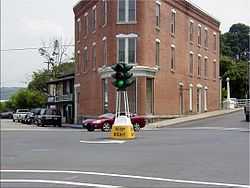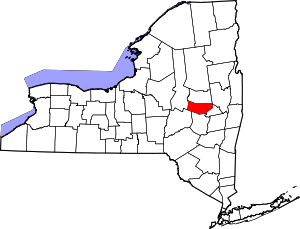Canajoharie (village), New York
| Canajoharie | |
|---|---|
| Village | |
|
| |
 Canajoharie Location within the state of New York | |
| Coordinates: 42°54′11″N 74°34′16″W / 42.90306°N 74.57111°WCoordinates: 42°54′11″N 74°34′16″W / 42.90306°N 74.57111°W | |
| Country | United States |
| State | New York |
| County | Montgomery |
| Area | |
| • Total | 1.3 sq mi (3.5 km2) |
| • Land | 1.3 sq mi (3.4 km2) |
| • Water | 0.0 sq mi (0.1 km2) |
| Elevation | 305 ft (93 m) |
| Population (2010) | |
| • Total | 2,229 |
| Time zone | Eastern (EST) (UTC-5) |
| • Summer (DST) | EDT (UTC-4) |
| ZIP code | 13317 |
| Area code(s) | 518 |
| FIPS code | 36-12111 |
| GNIS feature ID | 0945734 |
Canajoharie /ˌkænədʒoʊˈhæri/ is a village in the town of Canajoharie in Montgomery County, New York, USA. As of the 2010 census, the village had a population of 2,229.[1] The name is said to be a Mohawk language term meaning "the pot that washes itself," a reference to the "Canajoharie Boiling Pot," a circular gorge in the Canajoharie Creek, just south of the village.
The village of Canajoharie is at the north border of the Town of Canajoharie; it is west of Amsterdam and east of Utica.
Canajoharie is home to one of at least three operating "dummy-lights" in the United States, located downtown at the intersection of Church, Mohawk and Montgomery Streets. It is a traffic signal on a pedestal which sits in the middle of an intersection, first installed in 1926. The other two are also located in New York State, in Beacon and Croton-on-Hudson.
The Erie Canal passes the north side of the village.
It was the headquarters for the manufacturing operations of the Beech-Nut baby food company. The plant was closed in March 2011 with production moving to Florida, New York in the same county.[2][3]
History
The current village is located east of the historic Canajoharie, a village of the Mohawk nation. The Mohawk Upper Castle Historic District in the former area contains the Upper Castle Church (1769) and archeological sites related to Iroquois history; it is a National Historic Landmark.
Palatine German settlers, refugees from religious wars in Europe, established a community in this area in the 1730s. It was called "Roofville" (the spelling was anglicized) after early inhabitant Johannes Rueff. The village was incorporated in 1829. During the middle of the 19th century, three fires almost obliterated the village. It was renamed Canajoharie.
Geography
According to the United States Census Bureau, the village has a total area of 1.3 square miles (3.5 km²), of which, 1.3 square miles (3.4 km²) of it is land and 0.04 square miles (0.1 km²) of it (2.99%) is water.
The village is on the south bank of the Mohawk River.
The New York State Thruway, New York State Route 5S (Erie Boulevard/East Main Street), and New York State Route 10 (Rock Street/Reed Street) pass through the village. On the opposite bank of the Mohawk is the community of Palatine Bridge, New York in the Town of Palatine; both names refer to the colonial German settlers.
Wintergreen Park is a mile from the village and offers views of the Canajoharie Gorge and the Canajoharie Falls.[4]
Demographics

.jpg)
As of the census[1] of 2000, there were 2,257 people, 925 households, and 589 families residing in the village. The population density was 1,741.5 people per square mile (670.3/km²). There were 1,007 housing units at an average density of 777.0 per square mile (299.1/km²). The racial makeup of the village was 96.46% White, 0.89% Black or African American, 0.53% Native American, 0.53% Asian, 0.44% from other races, and 1.15% from two or more races. Hispanic or Latino of any race were 1.51% of the population.
There were 925 households out of which 33.0% had children under the age of 18 living with them, 44.9% were married couples living together, 15.0% had a female householder with no husband present, and 36.3% were non-families. 30.5% of all households were made up of individuals and 13.7% had someone living alone who was 65 years of age or older. The average household size was 2.40 and the average family size was 2.95.
In the village the population was spread out with 26.2% under the age of 18, 8.0% from 18 to 24, 25.7% from 25 to 44, 22.6% from 45 to 64, and 17.6% who were 65 years of age or older. The median age was 38 years. For every 100 females there were 90.3 males. For every 100 females age 18 and over, there were 84.3 males.
The median income for a household in the village was $32,169, and the median income for a family was $44,250. Males had a median income of $30,476 versus $24,125 for females. The per capita income for the village was $17,850. About 13.0% of families and 12.4% of the population were below the poverty line, including 19.7% of those under age 18 and 1.1% of those age 65 or over.
Notable people
- Susan B. Anthony, women's rights pioneer, taught school here.
- Joseph Brant, Mohawk chief.
- Mary Brant, Mohawk leader.
- Alfred Conkling, was a lawyer, statesman, and jurist.
- Frederick Conkling, son of Alfred Conkling and brother of Roscoe Conkling. He became a US Representative for the state of New York.
- Josiah Failing, 4th mayor of Portland, Oregon. He gained much of his wealth, as an entrepreneur through general merchandise.
- Bernhard Gillam, a political cartoonist. He died of typhoid in Canajoharie, New York.
- Myron Grimshaw, major league baseball player. A right fielder for the Boston Red Sox for three seasons, 1905-1907.
- Thomas James, a former slave who became a minister in upstate New York, and published a well-regarded memoir.
- Jacob Klock, was the colonel of the 2nd regiment of the Tryon County militia during the American Revolutionary War.
- Sean MacFarland, Lieut. Gen., Commanding General of US Army's 1st Armored Division and Fort Bliss, Texas, later Commanding General of US Army's III Corps and Fort Hood, Texas
- Charles McVean, US Representative for the state of New York. While in Canajoharie, he was the editor of the towns newspaper.
- Ots-Toch, 17th-century Mohawk woman from Canajoharie who married the Dutch trader Cornelius Anthonisse Van Slyck; together they founded the Van Slyck family in New Netherland.
- Edwin M. Randall, Chief Justice for the state of Florida.
- Hendrick Theyanoguin, Mohawk leader.
- Benjamin F. VanAlstyne, was head coach of Michigan State University basketball team from, (1927–1949).
- Rebecca Winters, Mormon pioneer.
References
- ↑ 1.0 1.1 "American FactFinder". United States Census Bureau. Retrieved 2008-01-31.
- ↑ "Beech-Nut ends production in Canajoharie", The Leader-Herald, 27 March 2011
- ↑ "Beech-Nut site drawing some interest", The Leader-Herald, 28 June 2011
- ↑ "Canajoharie-Palatine Chamber of Commerce". Archived from the original on 2007-10-07. Retrieved 2007-10-15.
Notes
- City of Beacon. Canajoharie, New York: Credits. Retrieved Sep. 30, 2008.
- Croton-on-Hudson Historical Society. Canajoharie, New York: Credits. Retrieved Sep. 30, 2008.
- Villages of Canajoharie & Palatine Bridge. Canajoharie, New York: Credits.
External links
- Brief area history
- Chamber of Commerce information
- Canajoharie Village Court
- The Arkell Museum at Canajoharie
| |||||||||||||||||||||||||||||
